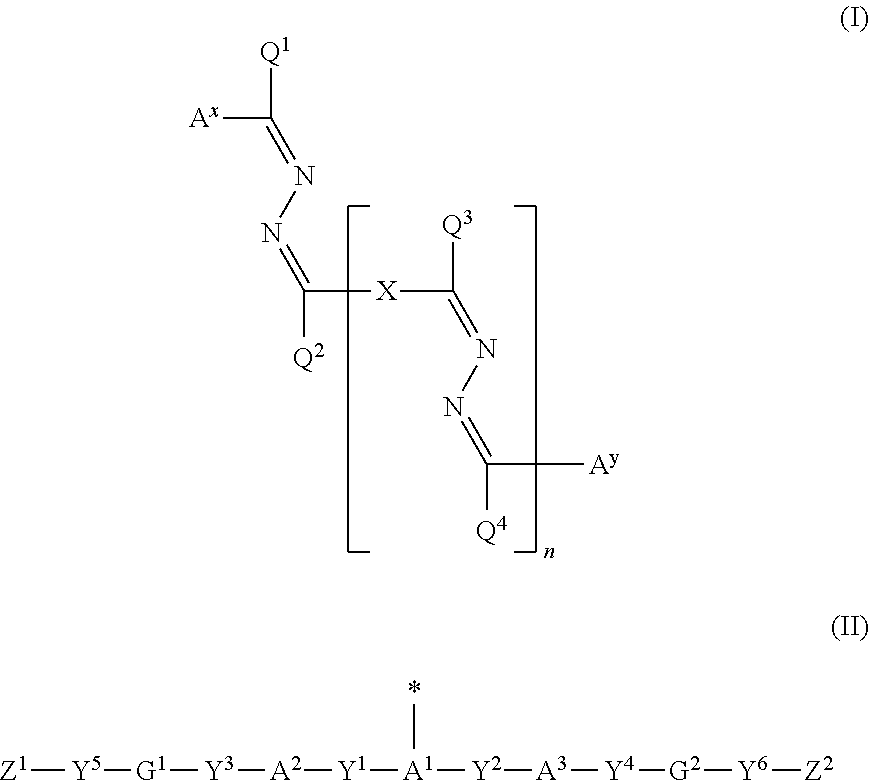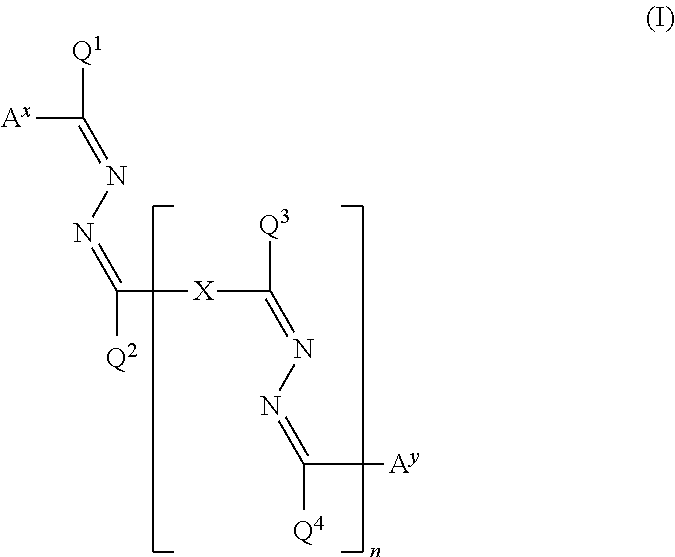Polymerizable compound, polymerizable composition, polymer, and optically anisotropic body
a technology of polymerizable compound and composition, applied in the direction of optical elements, instruments, organic chemistry, etc., can solve the problems of increasing cost, narrow range in which liquid crystallinity is obtained, and low solubility of solvent normally used for industrial processes, etc., to achieve easy and inexpensive production, easy to obtain optical films, and satisfactory performan
- Summary
- Abstract
- Description
- Claims
- Application Information
AI Technical Summary
Benefits of technology
Problems solved by technology
Method used
Image
Examples
example 1
Synthesis of Compound 1
[0181]
Step 1: Synthesis of intermediate A
[0182]
[0183]A four-necked reactor equipped with a thermometer was charged with 20 g (144.8 mmol) of 2,5-dihydroxybenzaldehyde, 105.8 g (362.0 mmol) of 4-(6-acryloylhex-1-yloxy)benzoic acid (manufactured by DKSH Japan K.K.), 5.3 g (43.4 mmol) of 4-(dimethylamino)pyridine, and 200 ml of N-methylpyrrolidone under a nitrogen stream to prepare a homogeneous solution. After the addition of 83.3 g (434.4 mmol) of 1-ethyl-3-(3-dimethylaminopropyl)carbodiimide hydrochloride (WSC) to the solution, the mixture was stirred at 25° C. for 12 hours. After completion of the reaction, the reaction mixture was added to 1.5 l of water, and extracted with 500 ml of ethyl acetate. The ethyl acetate layer was dried over anhydrous sodium sulfate, and sodium sulfate was filtered off. Ethyl acetate was evaporated from the filtrate under reduced pressure using a rotary evaporator to obtain a light yellow solid. The light yellow solid was purifie...
example 2
Synthesis of Compound 2
[0191]
Step 1: Synthesis of Intermediate B
[0192]
[0193]A four-necked reactor equipped with a thermometer was charged with 0.56 g (11.18 mmol) of hydrazine monohydrate and 10 ml of ethanol under a nitrogen stream to prepare a homogeneous solution. After the addition of 1.5 g (11.18 mmol) of 2,5-dihydroxybenzaldehyde and 10 ml of THF to prepare a homogenous solution, the solution was stirred at 25° C. for 1 hour. After the addition of 550 mg (3.98 mmol) of terephthalaldehyde to the reaction mixture, the mixture was stirred at 25° C. for 6 hours. After completion of the reaction, a precipitated solid was filtered off by suction filtration. The solid was dried under vacuum to obtain 0.8 g of an intermediate B as a yellow solid (yield: 50.0%). The intermediate B was used directly for the subsequent reaction without purification.
Step 2: Synthesis of Compound 2
[0194]A four-necked reactor equipped with a thermometer was charged with 2.54 g (8.69 mmol) of 4-(6-acryloylhe...
example 3
Synthesis of Compound 3
[0199]
Step 1: Synthesis of Intermediate C
[0200]
[0201]A four-necked reactor equipped with a thermometer was charged with 2.00 g (13.1 mmol) of 2,5-dihydroxyacetophenone, 296 mg (5.92 mmol) of hydrazine monohydrate, and 20 ml of 1-propanol under a nitrogen stream. The mixture was stirred at 60° C. for 4 hours. The reaction mixture was cooled to 25° C., and poured into 10% sodium bicarbonate water to precipitate crystals. The crystals were filtered off by suction filtration, washed with water, and air-dried. The crystals were used directly for the subsequent reaction without purification.
[0202]The structure of the target product was identified by 1H-NMR.
[0203]1H-NMR data for intermediate C
[0204]1H-NMR (500 MHz, CDCl3, TMS, δ ppm): 12.30 (s, 2H), 9.05 (s, 2H), 7.10 (d, 2H, J=2.5 Hz), 6.85 (dd, 2H, J=2.5 Hz, 9.2 Hz), 6.80 (d, 2H, J=9.2 Hz), 2.46 (s, 6H).
Step 2: Synthesis of Compound 3
[0205]A four-necked reactor equipped with a thermometer was charged with 3.27 g (1...
PUM
| Property | Measurement | Unit |
|---|---|---|
| boiling point | aaaaa | aaaaa |
| boiling point | aaaaa | aaaaa |
| boiling point | aaaaa | aaaaa |
Abstract
Description
Claims
Application Information
 Login to View More
Login to View More - R&D
- Intellectual Property
- Life Sciences
- Materials
- Tech Scout
- Unparalleled Data Quality
- Higher Quality Content
- 60% Fewer Hallucinations
Browse by: Latest US Patents, China's latest patents, Technical Efficacy Thesaurus, Application Domain, Technology Topic, Popular Technical Reports.
© 2025 PatSnap. All rights reserved.Legal|Privacy policy|Modern Slavery Act Transparency Statement|Sitemap|About US| Contact US: help@patsnap.com



